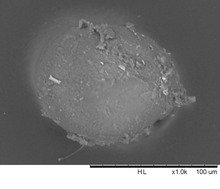Glomerales
| Glomerales Temporal range:
| |
|---|---|

| |
| Glomus mosseae | |
| Scientific classification | |
| Domain: | Eukaryota |
| Kingdom: | Fungi |
| Division: | Glomeromycota |
| Class: | Glomeromycetes |
| Order: | Glomerales Morton & Benny, 1990[1] |
| Families and genera | |
| Synonyms | |
|
Glomales | |
Wikispecies has information related to Glomerales.
Glomerales is an order of
fungi within the phylum Glomeromycota
.
Biology
These fungi are all
mutualists. Most employ the arbuscular mycorrhizal method of nutrient exchange with plants. They produce large (.1-.5mm) spores (azygospores and chlamydospores) with thousands of nuclei.[2]
Phylogeny
All members of their phylum were once thought to be related to the
Endogonaceae, but have been found through molecular sequencing data, to be a closer relation to the Dikarya.[3] Their fossil record extends back to the Ordovician period (460 million years ago).[2]
Meiosis
Glomerales fungi were thought to have reproduced clonally for several hundred million years and are therefore an ancient asexual lineage.[4] However, homologs of 51 meiotic genes, including seven genes specific for meiosis, were found to be conserved in the genomes of four Glomus species.[4] Thus it now appears that these supposedly ancient asexual fungi may be capable of meiosis and perhaps also of a cryptic sexual or parasexual cycle.[4]
Orthography
The family name
International Code of Botanical Nomenclature
. The incorrect spellings are commonplace in the literature.
See also
References
- ^ J.B. Morton (1990). "Revised classification of the arbuscular mycorrhizal fungi (Zycomycetes): a new order, Glomales, two new families, Acaulosporaceae and Gigasporaceae, with an emendation of Glomaceae". Mycotaxon. 37: 473.
- ^ ISBN 0-471-52229-5.
- .
- ^ a b c Sébastien Halary, Shehre-Banoo Malik, Levannia Lildhar, Claudio H. Slamovits, Mohamed Hijri, Nicolas Corradi, Conserved Meiotic Machinery in Glomus spp., a Putatively Ancient Asexual Fungal Lineage, Genome Biology and Evolution, Volume 3, 2011, Pages 950–958, https://doi.org/10.1093/gbe/evr089
